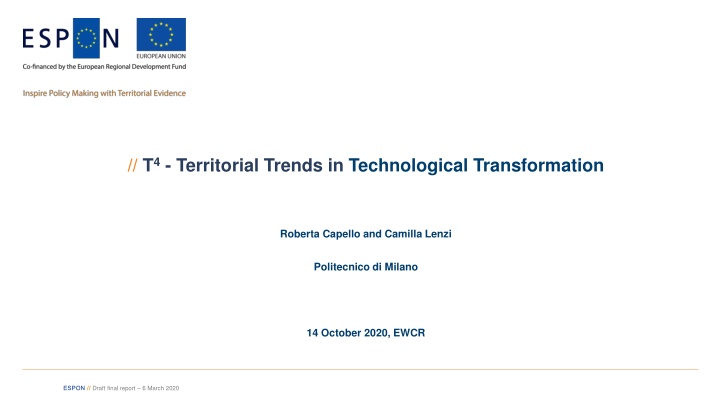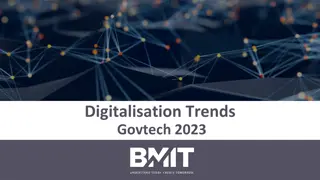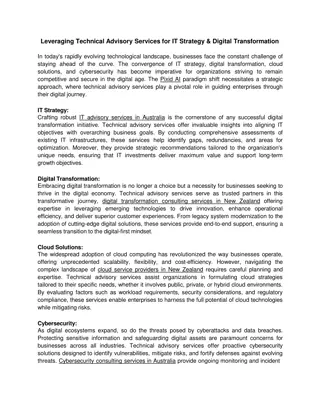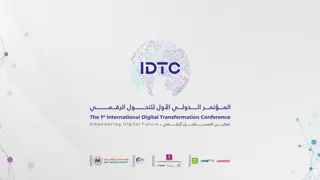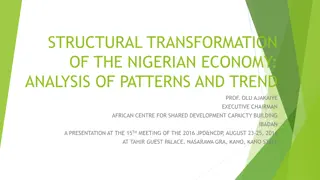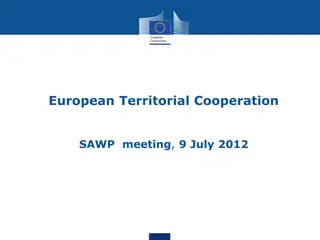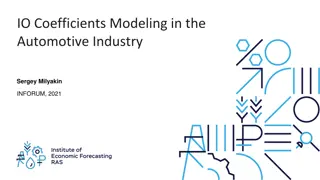Territorial Trends in Technological Transformation
This report explores the 4.0 technological transformation, its regional impacts, and the reorganization of economic activities driven by new technologies. It delves into the market for new technologies, the industry changes, and the shift towards service-based profitability. The discussion also covers where these transformations occur and the disparities between leading regions and low-tech regions.
Download Presentation

Please find below an Image/Link to download the presentation.
The content on the website is provided AS IS for your information and personal use only. It may not be sold, licensed, or shared on other websites without obtaining consent from the author.If you encounter any issues during the download, it is possible that the publisher has removed the file from their server.
You are allowed to download the files provided on this website for personal or commercial use, subject to the condition that they are used lawfully. All files are the property of their respective owners.
The content on the website is provided AS IS for your information and personal use only. It may not be sold, licensed, or shared on other websites without obtaining consent from the author.
E N D
Presentation Transcript
// T4- Territorial Trends in Technological Transformation Roberta Capello and Camilla Lenzi Politecnico di Milano 14 October 2020, EWCR Draft final report 6 March 2020
// Aim of the presentation The presentation has the aim to reply to the following questions: What is the 4.0 technological transformation? Where does 4.0 technological transformation take place? What are the regional impacts of 4.0 technological transformation? T4 EWCR, 14 October 2020
What is the 4.0 technological transformation? T4 EWCR, 14 October 2020
// What is the 4.0 technological transformation? Technological transformation is defined as a reorganisation of economic activities around new possible value creation channels (new business models) generated by the new 4.0 technologies, leading to profound socio-economic changes. The 4.0 technological revolution encompasses three main completely different technological transformations: the transformation in the market for new technologies, through the opening of market opportunities to newcomers and to user innovators, due to the recombinatorial nature of 4.0 technologies; 4.0 Industry, with new business models in which efficiency gains rest on the production of mass customised products and on the integration and orchestration of distant machines along the value chain; Servitisation of the society, where a radical shift from selling products to offering services as the main source of profitability for firms, through the creation of new digital markets for services. T4 EWCR, 14 October 2020
Where does 4.0 technological transformation take place? T4 EWCR, 14 October 2020
// Transformation in the market for new technologies The market for new technologies is radically transformed by the new nature of the 4.0 technologies. Their infinite replicability and transferability of knowledge permits limited if null R&D expenditures and enormous profit margins. Spatial consequence: opportunity for regions with no 3.0 knowledge to enter the market T4 EWCR, 14 October 2020
// Leading regions and low-tech regions More than 40% of regions are excluded from any creative effort in the development of 4.0 technologies (122 regions out of 292) Technological cumulativeness is in general high, (i.e. 57 regions have a leadership position in terms of 4.0 technologies and 3.0 technologies.
// New islands of market opportunities Technological leapfrogging is possible leading to the rise of new islands of market opportunities (23 out of 292) in regions located both in relatively less innovative areas of leading countries (e.g. FR, UK, SE, NL, DE) but also in follower countries (e.g. IT, PT, ES) and, even more importantly, in eastern countries and not only in capital regions (e.g. PL, CZ, SI, RO).
// Industry 4.0 Industry 4.0 describes a process of increasing digitalisation, robotisation and automation of the manufacturing environment, enriched with the creation of digital value chains to enable inputs from suppliers and customers, and between business partners (Lasi et al., 2014). Smart factories, CPS, self-organization, new systems in distribution and procurement, new systems in the development of products and services, adaptation to human needs and corporate social responsibility are all part of the new Industry 4.0 production model. T4 EWCR, 14 October 2020
// Servitization Servitisation was used to identify a strategy put in place by manufacturing firms in developed countries to offer services together with the product, in order to compete with firms in developing countries Nowadays, servitisation refers also to the supply of products offered on virtual markets via a website, or via digital intermediaries. Through indicators of 4.0 technology adoption and regional sectoral specialization in sectors involved in technological transformations, T4 project highlighted where Industry 4.0 and Servitisation take place the most. T4 EWCR, 14 October 2020
// Regional transformation patterns Servitisation takes place in a few number of regions, especially large city regions. Industry 4.0 are in a few number, located mainly in Southern Germany and Northern Italy. Digitalisation of traditional service is the most populated among the five patterns, mainly concentrated in Southern Italy regions, some regions in Spain, parts of the UK (with the exception of London and its surroundings), Baltic regions, regions in Norway, Northern Germany, part of the Netherlands. Robotisation of traditional manufacturing activities are mostly concentrated in Europe, especially in France, Poland, Central Italy, Hungary register the adoption of robots in induced sectors; Niches of robotisation are located mainly in Eastern countries, Greece, part of Spain and a few regions in France. T4 EWCR, 14 October 2020
What are the regional impacts of the 4.0 technological transformation? T4 EWCR, 14 October 2020
// GDP growth performance by regional transformation patterns After controlling for many other explanatory factors, the map shows that the highest GDP p.c. growth is registered in the most complex and articulated technological transformations, namely the servitisation and the Industry 4.0 ones. Regions where the adoption is limited to niche of excellence (niches of robotisation) are characterised by the lowest rates of GDP p.c. growth. T4 EWCR, 14 October 2020
// Adoption efficiency by regional transformation pattern: best practice Best practices tend to be located in the North, from Scandinavia, down to Northern France and Germany, till Northern Italy, while they are totally absent in Eastern countries. T4 EWCR, 14 October 2020
// Impact on employment levels The adoption of robots in technology sectors generates a negative impact on employment level Robots replace jobs when adopted in technology manufacturing sectors. The adoption of robots and online sales in all other sectors does not seem to have a direct effect on employment levels, in general. T4 EWCR, 14 October 2020
// Impact on low-skill employment Robots adoption Online sales adoption Robots displace low-skill jobs. Online sales, instead, generate an expansion of the share of low-skill jobs: gig-jobs! T4 EWCR, 14 October 2020
// Impact on high-skill employment Impact of robot adoption Impact of online sales adoption Robots in manufacturing sectors displace high-skill jobs! Online sales generate an expansion of the share of high-skill jobs. Polarisation of the labour market! T4 EWCR, 14 October 2020
// Tailored made policy recommendations (1) 1. Policy measures should concentrate on supporting especially laggard regions the possibility to become islands of innovation , creating and supporting the necessary creativity to occur. In this sense, the launch of training programmes for professionals and entrepreneurs with relevant background is important, so to avoid outdated skills and competences in new 4.0 technologies. 2. Complex technology transformations call for a blending between technological scaling up, experiment and utilisation of cutting-edge technologies, and business ideas in order to be exploited to achieve efficiency gains. Policies have to be balanced among technological knowledge, new business opportunities and stimuli of new opportunities. 3. Best practices exist for each transformation. Policies have to make the best use of such situations, and exploit them as pilot cases. An efficient way to transfer the know-how from best practices, especially in the public sphere, is through cooperation agreements among local institutions. The Oulu declaration cooperation on Digital Transformation and Smart Growth is a good example in such respect. 4. Policies should guarantee that Eastern countries are not be left behind in this process. As the policy review has shown, the aims of the existing policy measures are rarely those of overcoming adoption barriers in lagging regions. 4.0 technologies should instead be interpreted as an effective way to solve underperformance of regions, and policy measures should be developed in such direction. Draft final report 6 March 2020
// Tailored made policy recommendations (2) 5. The impact on the labour market is present, and complex. Education and training policies in the form of increase intake in HEI to ensure future supply of Industry 4.0 professionals, of cooperation between universities and industries in the design of curricula, of attraction of professionals from best practice regions and countries are necessary actions to be undertaken. The priority should be to speed on digital skills for both young people and adults by updating the Digital Education Action Plan, as suggested by the political guidelines for the European Commission 2019-2024 (van der Leyen, 2019). 6. The substitution of jobs with technology calls for legislation for a coordinated European approach on the human and ethical implications of Artificial Intelligence. In this respect, the proposal of the new President of the European Commissioner, Ursula von der Leyen, to develop a new Digital Services Act to upgrade liability and safety rules for digital platforms, services and products, and achieve a Digital Single Market, is well taken. Draft final report 6 March 2020
Thank you very much for your attention! T4 EWCR, 14 October 2020
